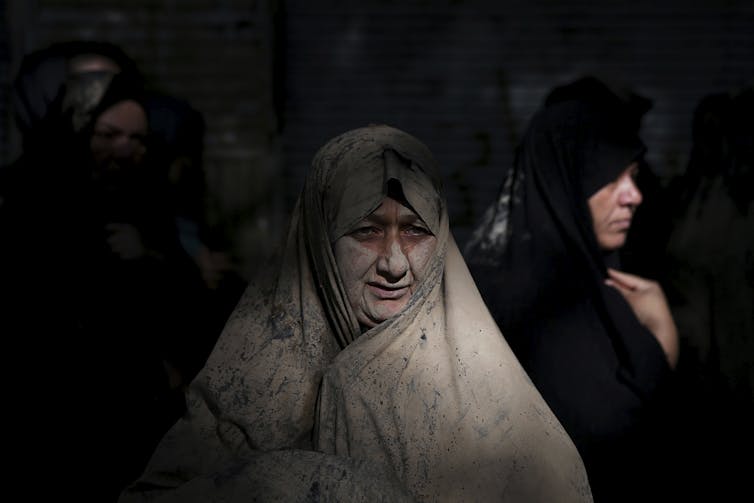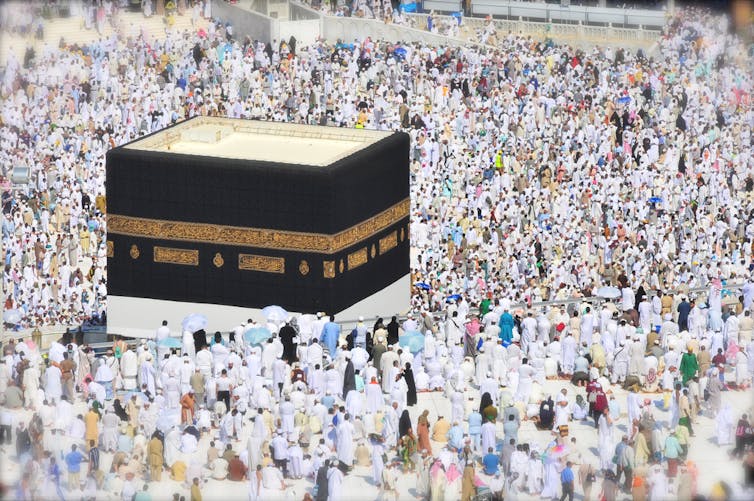The Split Into Sunni and Shia Divisions of Islam Can Be Traced to
Tensions betwixt Sunnis and Shias have been flaring up, with several incidents of violence reported in recent months: Nearly recently a suicide bomber killed at least 29 people when he blew himself up at the largest Shiite Muslim mosque in Transitional islamic state of afghanistan'due south Herat province on Tuesday, Baronial 1.
Earlier in June, the Islamic Country claimed responsibility for 2 attacks that claimed at least 12 lives in Islamic republic of iran. Islamic republic of iran is a Shia Muslim majority state oft in tension with Sunni states and extremist groups like the Islamic Country or al-Qaeda.
As a scholar of Islam and a public educator, I often field questions about Sunnis, Shias and the sects of Islam. What exactly is the Shia-Sunni split? And what is its history?
History of dissever
Both Sunnis and Shias – drawing their faith and practice from the Qur'an and the life of the Prophet Muhammad – hold on nearly of the fundamentals of Islam. The differences are related more to historical events, ideological heritage and issues of leadership.
The offset and central difference emerged after the death of Prophet Muhammad in A.D. 632. The effect was who would be the caliph – the "deputy of God" – in the absence of the prophet. While the majority sided with Abu Bakr, one of the prophet's closest companions, a minority opted for his son-in-law and cousin – Ali. This group held that Ali was appointed by the prophet to be the political and spiritual leader of the fledgling Muslim community.
Afterwards, those Muslims who put their faith in Abu Bakr came to be chosen Sunni ("those who follow the Sunna," the sayings, deeds and traditions of the Prophet Muhammad) and those who trusted in Ali came to be known as Shia (a contraction of "Shiat Ali," significant "partisans of Ali").
Abu Bakr became the start caliph and Ali became the 4th caliph. Nonetheless, Ali's leadership was challenged by Aisha, the prophet'southward wife and daughter of Abu Bakr. Aisha and Ali went to battle against each other virtually Basra, Iraq in the Battle of the Camel in A.D. 656. Aisha was defeated, merely the roots of partitioning were deepened. Afterward, Mu'awiya, the Muslim governor of Damascus, also went to battle against Ali, further exacerbating the divisions in the community.
In the years that followed, Mu'awiya assumed the caliphate and founded the Ummayad Dynasty (A.D 670-750). Ali's youngest son, Hussein – born of Fatima, the prophet'southward daughter – led a group of partisans in Kufa, Iraq against Mu'awiya's son Yazid. For the Shias, this battle, known as the Battle of Karbala, holds enormous historical and religious significance.

Hussein was killed and his forces defeated. For the Shia customs, Hussein became a martyr. The day of the battle is commemorated every year on the Solar day of Ashura. Held on the tenth day of Muharram in the Islamic lunar calendar, scores of pilgrims visit Hussein'due south shrine in Karbala and many Shia communities participate in symbolic acts of flagellation and suffering.
Leadership disagreements
Over time, Islam continued to expand and develop into evermore complex and overlapping societies that spanned from Europe to sub-Saharan Africa, North Africa to Asia. This development demanded more than codification forms of religious and political leadership.
Sunnis and Shias adopted different approaches to these issues.
Sunni Muslims trusted the secular leadership of the caliphs during the Ummayad (based in Damascus from A.D. 660-750) and Abbasid (based in Iraq from 750-1258 and in Cairo from 1261-1517) periods. Their theological foundations came from the four religious schools of Islamic jurisprudence that emerged over the seventh and eighth centuries.
To this 24-hour interval, these schools help Sunni Muslims decide on issues such as worship, criminal constabulary, gender and family unit, cyberbanking and finance, and fifty-fifty bioethical and environmental concerns. Today, Sunnis comprise about lxxx-xc percent of the global Muslim population.
On the other hand, Shias relied on Imams every bit their spiritual leaders, whom they believed to be divinely appointed leaders from among the prophet's family. Shia Muslims go along to maintain that the prophet's family unit are the sole genuine leaders. In the absence of the leadership of direct descendants, Shias engage representatives to rule in their place (often called ayatollahs). Shias are a minority of the global Muslim population, although they have strong communities in Iraq, Pakistan, Republic of albania, Yemen, Lebanon and Iran. There are besides dissimilar sects within Shia Islam.
Differences masked during Hajj
Other disputes that continue to exacerbate the divide include issues of theology, practice and geopolitics.
For example, when it comes to theology Sunnis and Shias depict from different "Hadith" traditions. Hadith are the reports of the words and deeds of the prophet and considered an authoritative source of revelation, second merely to the Quran. They provide a biographical sketch of the prophet, context to Quranic verses, and are used by Muslims in the application of Islamic law to daily life. Shias favor those that come from the prophet's family and closest associates, while Sunnis cast a broader net for Hadith that includes a broad array of the prophet'southward companions.
Shias and Sunnis differ over prayer besides. All Sunni Muslims believe they are required to pray five times a day, only Shias can condense those into three.

During the Hajj – the pilgrimage to Mecca, held annually and obligatory for all Muslims once in a lifetime – it may seem that these differences are masked, every bit both Sunnis and Shias gather in the holy city for rituals that reenact the holiest narratives of their faith. And yet, with Saudi authorities overseeing the Hajj, there have been tensions with Shia governments such as Iran over claims of discrimination.
And when it comes to leadership, the Shia have a more than hierarchical structure of political and religious authority invested in formally trained clergy whose religious say-so is transnational. There is no such structure in Sunni Islam.
The greatest splits today, however, come downward to politics. Although the majority of Sunni and Shia are able to live peacefully together, the current global political landscape has brought polarization and sectarianism to new levels. Shia-Sunni conflicts are raging in Syrian arab republic, Iraq, Lebanese republic and Pakistan and the split up is growing deeper across the Muslim world.
This historical schism continues to permeate the daily lives of Muslims around the world.
Source: https://theconversation.com/what-is-the-shia-sunni-divide-78216
0 Response to "The Split Into Sunni and Shia Divisions of Islam Can Be Traced to"
Post a Comment